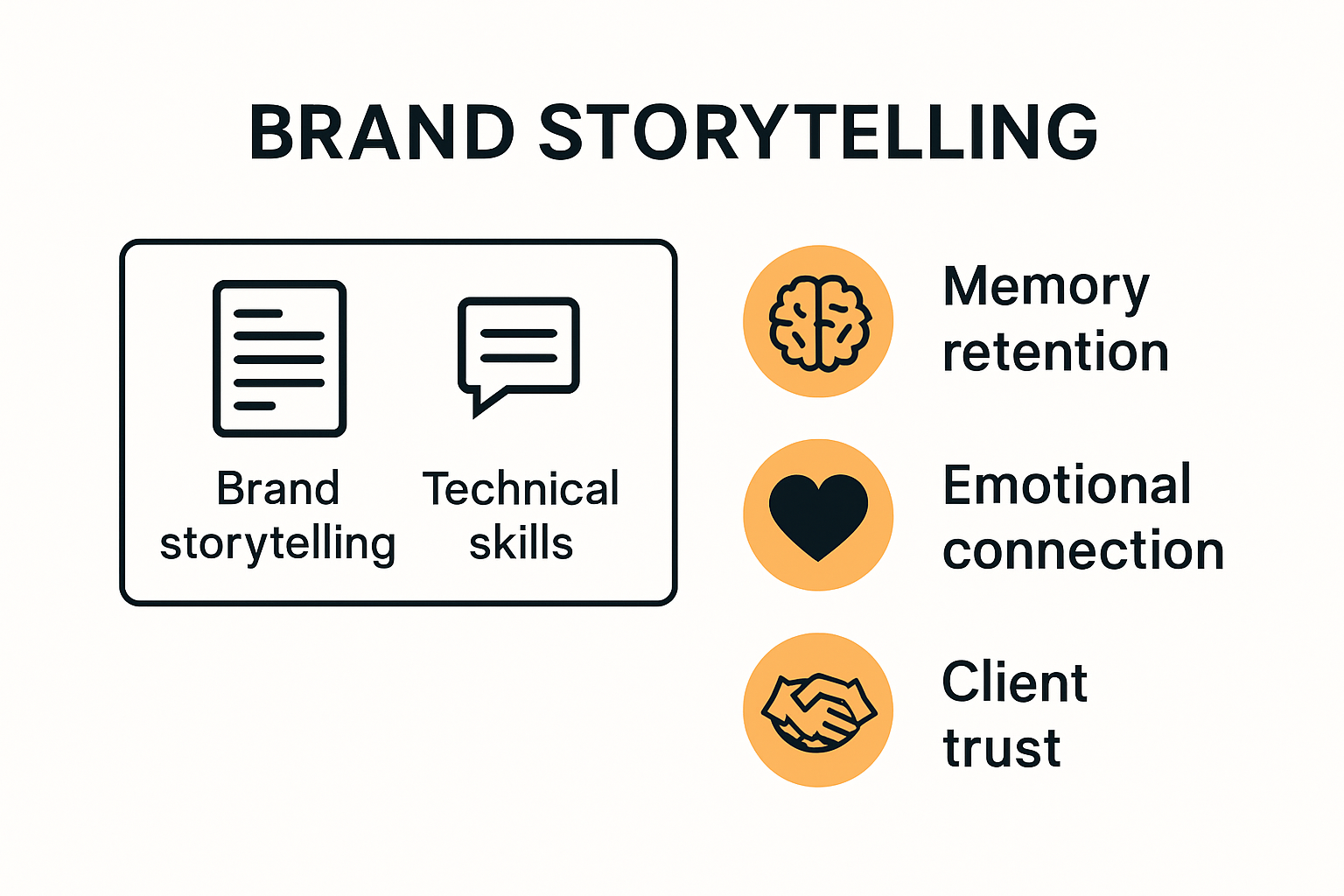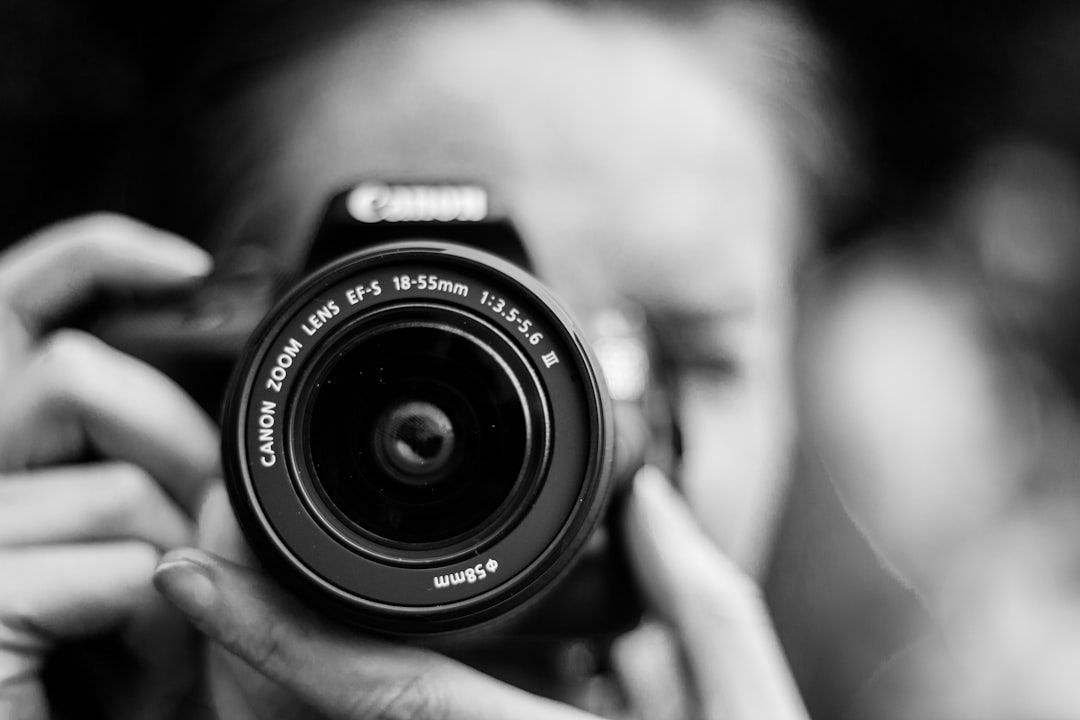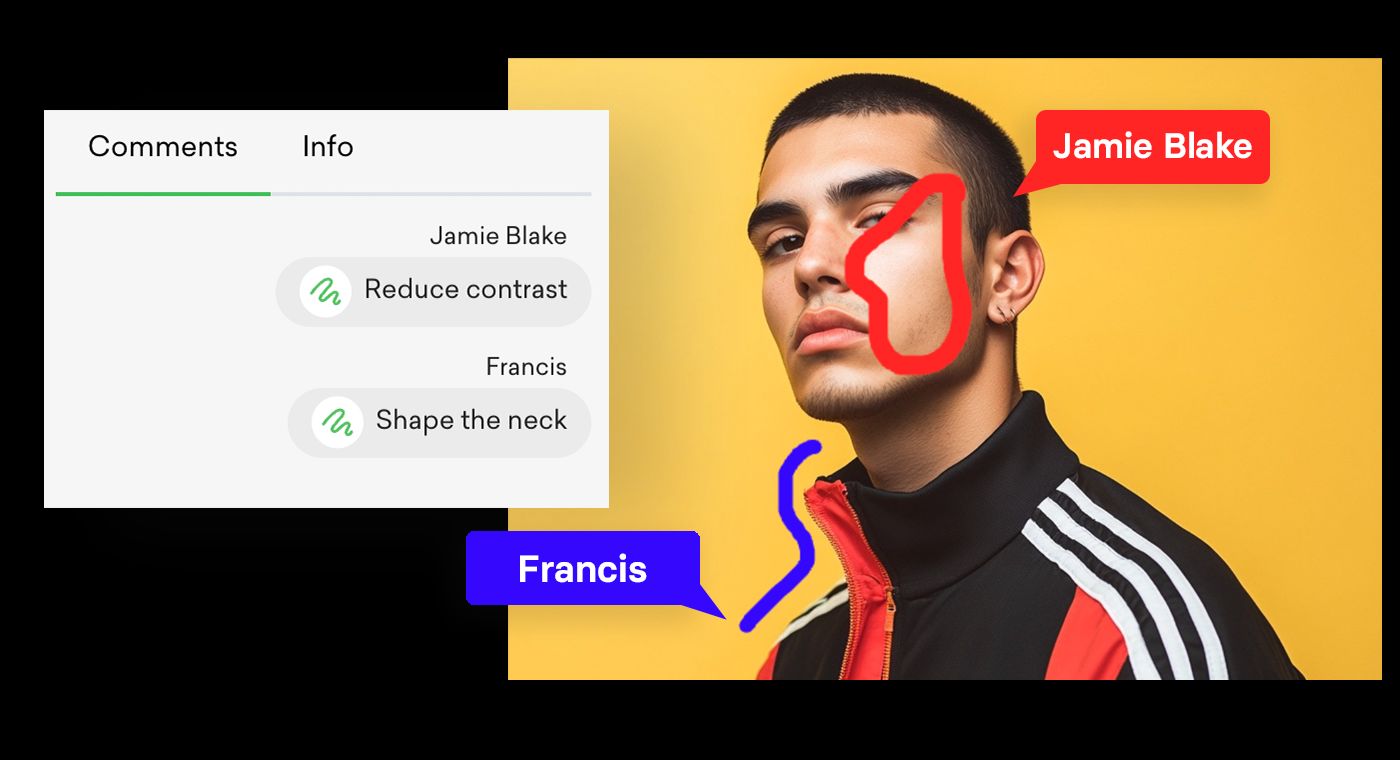Brand stories are shaping the way creatives are hired and remembered. People are actually 22 times more likely to remember a story than a fact. Surprised? Most think your work alone will land you clients, but research shows that emotional connection beats technical skill every time. The real secret is that sharing your journey and values draws professional opportunities right to your door.
Table of Contents
- Why Brand Storytelling Matters For Creatives
- Key Elements Of A Compelling Brand Story
- Step-By-Step Guide To Crafting Your Own Brand Story
- Real Brand Storytelling Examples In Creative Industries
Quick Summary
| Takeaway | Explanation |
|---|---|
| Brand storytelling fosters emotional connections. | Crafting a narrative makes your work memorable and relatable to clients, enhancing engagement. |
| Authenticity builds client trust. | Sharing genuine stories from your creative journey fosters deeper relationships and shows why you create. |
| Define your professional values clearly. | Establishing core values will anchor your brand story and convey your mission effectively. |
| Use narrative structure in your story. | Organizing your brand story with a clear arc makes it engaging and relatable to your audience. |
| Continuously refine your brand narrative. | Your story should evolve as you grow, keeping it relevant and aligned with your professional identity. |
Why Brand Storytelling Matters for Creatives
Brand storytelling represents a powerful communication strategy that transforms how creative professionals connect with their audience. For photographers, videographers, designers, and other visual artists, crafting a compelling narrative goes far beyond simply showcasing work—it’s about creating meaningful connections that resonate deeply with potential clients and collaborators.
The Psychological Power of Storytelling
Research by Jerome Bruner reveals a fascinating insight: people are 22 times more likely to remember information when it’s presented through a story rather than as raw facts. This neurological phenomenon underscores why storytelling is not just an artistic choice but a strategic communication tool for creative professionals.
For creatives, this means your brand story can serve as a powerful mechanism to transform abstract professional skills into a memorable, emotionally resonant experience. When you share the journey behind your work—the inspirations, challenges, and unique perspectives that drive your creativity—you create a narrative that potential clients can connect with on a deeper level.
Converting Emotional Connection into Professional Opportunities
Marketing research demonstrates that 55% of consumers become more likely to purchase when they feel emotionally connected to a brand’s story. For creative professionals, this statistic translates directly into professional opportunities. Your story becomes more than a portfolio—it’s an invitation for clients to understand your unique value proposition.
Consider how your personal narrative intersects with your professional work. Are you driven by a mission to capture untold stories? Do you have a transformative experience that shaped your artistic approach? These narrative elements can distinguish you in a competitive marketplace, making your brand memorable and engaging.

Building Trust Through Authentic Narratives
Authenticity remains the cornerstone of effective brand storytelling. Creative professionals possess a unique advantage—their work is inherently personal and expressive. By sharing genuine stories about your creative process, the challenges you’ve overcome, and the passion that fuels your work, you build trust with potential clients.
Your brand story should reveal not just what you do, but why you do it. This approach transforms transactional interactions into meaningful professional relationships. Clients want to work with creators who have depth, vision, and a compelling reason for their artistic pursuits.
In the visual arts, storytelling becomes a visual language itself. Each project, each image, each creative decision contributes to the broader narrative of your professional identity. By intentionally crafting and communicating this narrative, you elevate your brand from a service provider to a storyteller with a unique perspective.
Key Elements of a Compelling Brand Story
Crafting a compelling brand story requires more than simply listing professional achievements. It demands a strategic approach that transforms your professional journey into a narrative that captivates and connects with your audience. Creative professionals must understand the essential elements that transform a mundane description into an engaging story.
To clarify the essential building blocks of an effective brand story for creatives, the table below outlines the three key elements and what each involves.
| Element | What It Involves |
|---|---|
| Narrative Architecture | Clear structure with a main character (you), challenge/conflict, and resolution. Unfolds as a journey, not a list of events. |
| Authenticity & Emotional Resonance | Sharing genuine experiences, vulnerabilities, values, and moments of growth to foster emotional connection. |
| Defining Your Brand Persona | Developing a consistent, compelling identity that extends beyond technical skills—reflects your philosophy and unique approach. |
The Narrative Architecture
Research in brand management reveals that effective brand stories require a clear plot structure similar to traditional storytelling. For creatives, this means constructing a narrative that includes key components: a central character (you), a challenge or conflict, and a transformative resolution.
Your brand story should not read like a resume but unfold like a journey. What obstacles have you overcome? What unique perspective drives your creative work? These elements create depth and make your professional narrative more than a simple chronology of events. The goal is to showcase not just what you do, but who you are as a creative professional.
Authenticity and Emotional Resonance
Branding research emphasizes that stories embedded with genuine values and relatable experiences enhance audience engagement. Authenticity becomes your most powerful storytelling tool. This means sharing not just successes, but vulnerabilities, learning moments, and genuine passion that define your creative journey.
Consider how your personal experiences shape your professional approach. Perhaps a challenging project taught you innovative problem solving. Maybe a mentor inspired your unique artistic vision. These authentic moments create emotional connections that transform potential clients from distant observers to invested collaborators.
Defining Your Brand Persona
Persona research highlights the importance of creating a well-defined central character in your brand narrative. For creative professionals, this means developing a consistent and compelling professional identity that goes beyond your technical skills.
Your brand persona is the personality that emerges through your story. Are you the innovative risk taker? The meticulous craftsperson? The storyteller who sees beauty in unexpected places? This persona should be reflected consistently across your portfolio, communication, and professional interactions.
Remember that a compelling brand story is not about perfection but about genuine human experience. It invites your audience into your world, showing them not just the polished final product, but the passion, creativity, and unique perspective that make your work extraordinary. When done effectively, your brand story becomes more than a marketing tool—it becomes an invitation to collaborate, to understand, and to connect.
Step-by-Step Guide to Crafting Your Own Brand Story
Creating a compelling brand story requires strategic planning and genuine self-reflection. This guide will walk you through a systematic approach to developing a narrative that authentically represents your professional identity and resonates with your target audience.
The following table summarizes the three major steps to building your brand story and the main actions each step entails.
| Step | Core Actions/Questions |
|---|---|
| Discover Your Unique Professional Origin | Reflect on what inspired you, key transformative moments, and the deeper motivation behind your creative journey. |
| Define Your Values and Mission | Identify your core principles, outline what change you seek through your work, and create a concise mission statement. |
| Craft & Communicate Your Narrative | Organize your story in a narrative arc and share consistently across portfolio, website, and professional interactions—revising as you grow. |
Discovering Your Unique Professional Origin
Start by exploring the roots of your creative journey. Narrative identity research suggests that personal stories are most powerful when they reveal genuine transformation and motivation.
Begin with critical reflection questions: What first sparked your passion for your creative field? What pivotal moments shaped your professional path? These questions help uncover the deeper narrative behind your work. For instance, a photographer might trace their inspiration to a childhood fascination with capturing moments, or a graphic designer might describe how a mentor’s guidance transformed their understanding of visual communication.
Document these personal insights. Look for themes that demonstrate not just skill, but passion, resilience, and unique perspective. Your origin story should feel genuine and provide insight into why you do what you do, beyond simply how you do it.
Defining Your Professional Values and Mission

Brand positioning research emphasizes that successful brand narratives are anchored in clear, consistent values. This means identifying the core principles that guide your creative work.
Create a values map that outlines your professional beliefs. What standards do you hold yourself to? What change do you want to create through your work? These values become the foundation of your brand story. A videographer might value authenticity and human connection. A designer might prioritize innovation and social impact.
Translate these values into a concise mission statement. This statement should be more than a description of services—it should communicate your broader professional purpose. For example: “I create visual stories that amplify unheard voices and challenge conventional perspectives.”
Crafting and Communicating Your Narrative
With your origin and values established, focus on narrative structure. Your brand story should follow a clear arc: introduction, challenge, resolution, and ongoing journey. This approach transforms your professional history from a static list of achievements to a dynamic, engaging narrative.
Consider the mediums through which you’ll communicate your story. Your portfolio, website, social media, and professional interactions should consistently reflect this narrative. Use visual and written elements that reinforce your unique professional identity.
Remember that your brand story is not a fixed document but an evolving narrative. As you grow professionally, your story will continue to develop. Regularly revisit and refine your narrative to ensure it remains authentic and relevant.
The most compelling brand stories are those that reveal vulnerability, showcase growth, and invite collaboration. Your narrative is an invitation—not just to potential clients, but to professional partners who share your vision and values. By crafting a story that is both personal and professional, you transform your brand from a service provider to a unique creative voice.
Real Brand Storytelling Examples in Creative Industries
Brand storytelling transcends theoretical concepts when examined through real-world examples from creative industries. These narratives demonstrate how professionals transform personal experiences and professional journeys into compelling brand identities that resonate deeply with audiences.
Museums and Cultural Institutions
Research examining the Museum of Modern Art (MoMA) provides an extraordinary example of institutional storytelling. MoMA does not merely display art but crafts a narrative that connects individual artistic expressions to broader cultural movements. Their storytelling approach goes beyond exhibition descriptions, presenting each artwork as part of a larger human story.
Photographers and visual artists can learn from MoMA’s strategy of contextualizing work. Instead of presenting images as isolated pieces, consider how each project connects to wider themes of human experience, social change, or personal transformation. This approach elevates your portfolio from a collection of images to a meaningful narrative about perception, emotion, and cultural insight.
Independent Creative Professionals
Consider the brand story of Stefan Sagmeister, a graphic designer who transformed personal creative challenges into a globally recognized narrative. Sagmeister’s brand is built not just on design excellence, but on his philosophy of challenging conventional design thinking. He shares stories about taking sabbaticals, experimenting with unconventional design approaches, and questioning industry norms.
His storytelling demonstrates that a compelling brand narrative can emerge from vulnerability, experimentation, and a willingness to share professional challenges. By documenting his creative process, including failures and unexpected discoveries, Sagmeister creates a brand story that is both authentic and inspirational. Creative professionals can learn that transparency and genuine storytelling can be more engaging than presenting a polished, unrealistic image of success.
Collaborative Creative Collectives
Creative collectives offer another fascinating lens into brand storytelling. Platforms like Magnum Photos, a cooperative of photographer-artists, illustrate how collective storytelling can create a powerful brand identity. Rather than focusing on individual achievements, Magnum crafts a narrative about collaborative documentation of human experiences across global contexts.
Their brand story is about more than individual photographs—it represents a commitment to documenting social change, human resilience, and diverse cultural experiences. Each photographer contributes to a larger narrative about visual storytelling as a form of social documentation and artistic expression.
These examples reveal that effective brand storytelling is not about self-promotion but about creating meaningful connections. Whether you are an individual creative professional or part of a larger collective, your brand story should invite your audience into a deeper understanding of your creative vision, professional journey, and the unique perspective you bring to your craft.
Successful brand stories are those that transcend simple service descriptions. They are invitations to understand a creative vision, to appreciate the human experience behind professional work, and to connect on a level that goes far beyond transactional interactions.
Frequently Asked Questions
What is brand storytelling?
Brand storytelling is the art of crafting a narrative that connects your personal journey, values, and creative work to engage clients and collaborators on an emotional level.
Why is storytelling important for creatives?
Storytelling is crucial for creatives because it makes their work memorable and relatable, fostering emotional connections that can lead to professional opportunities and client trust.
How can I define my brand persona?
To define your brand persona, reflect on your unique approach to creativity, the personality traits you want to convey, and ensure consistency in how you present yourself across all platforms.
What are the key elements of a compelling brand story?
The key elements of a compelling brand story include narrative architecture (having a clear structure), authenticity and emotional resonance (sharing genuine experiences), and a well-defined brand persona.
Transform Your Brand Story Into A Visual Experience Your Clients Remember
You have crafted a narrative that captures your journey and values, but delivering that story through scattered files and cluttered links can weaken the emotional impact you worked so hard to build. The article highlights how trust and authentic storytelling set creatives apart. Yet, when your work reaches clients through disjointed folders or outdated transfer tools, you risk losing the very connection your brand story promises.

Move beyond generic file sharing. Elevate your client experience by presenting your visuals in elegant, branded galleries that reinforce your unique story. With Pikd, you can organize, share, and collect feedback on your work within a collaborative space designed just for creative professionals. Show clients not just your talent but your entire vision. Ready to make every client interaction as powerful as your narrative? Get started with Pikd today and deliver your next chapter with confidence.

































